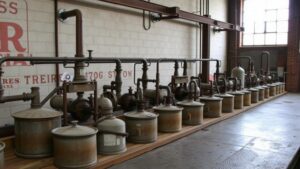Forgotten Slave Plantation Tools: Tracing Artifacts from America’s Past
Forgotten Slave Plantation Tools: Tracing Artifacts from Americas Past
The legacy of slavery in the United States has shaped multiple facets of contemporary society, yet many aspects remain under-explored. One such area is the role of tools and artifacts utilized on slave plantations. This article aims to delve into the significance of these often-overlooked artifacts, examining their historical context, functionality, and implications for modern understanding of plantation life and the enslaved individuals who lived it.
The Historical Context of Slave Plantations
From the early 17th century until the Civil War in the mid-19th century, slave labor became a cornerstone of the Southern economy. Plantations were primarily focused on cash crops such as tobacco, rice, and cotton, driving the demand for forced labor. According to the U.S. Census, in 1860, nearly 4 million enslaved people were living in the United States, predominantly in Southern states like Virginia, South Carolina, and Louisiana.
The Unique Functionality of Plantation Tools
Plantation tools were specifically designed to facilitate the labor-intensive work required to cultivate crops. Various implements reflect the brutal yet systematic nature of agricultural work performed by enslaved individuals. Some tools include:
- Hand Plows: A primary tool for tilling soil, hand plows were often made from wood and metal. Enslaved individuals used them to prepare land for planting crops.
- Hoes: Essential for weeding and cultivating the soil, hoes were commonly seen as a symbol of agricultural labor. were often handmade and varied significantly in design.
- Wheat Fans: Used in the harvesting and processing of crops, especially for separating grain from chaff, these tools indicate the sophistication of agricultural practices.
Archaeological Discoveries and Significance
Recent archaeological endeavors have uncovered a wealth of artifacts from plantations across the United States. Sites such as the Mount Clare Museum House in Baltimore, Maryland, and the Whitney Plantation in Wallace, Louisiana, provide substantial insight into the tools used by enslaved individuals. Discoveries range from simple farming implements to items used in domestic settings, embodying the daily lives of those who endured slavery.
Case Study: The Whitney Plantation
Established in 1752 and operational for over a century, the Whitney Plantation is notable for its focus on the enslaved experience. Recent excavations have revealed numerous artifacts, including:
- Lifters and Grubbing Hoes: These tools illustrate the physical demands of agricultural work, emphasizing the labor-intensive processes of crop production.
- Animal Yokes: These artifacts highlight the integration of animal labor alongside enslaved labor in farming operations.
Such artifacts provide a tangible connection to the past, allowing modern audiences to better grasp the realities faced by those on the plantation.
Implications for Understanding Slavery and Culture
Tools and artifacts from slave plantations not only serve to narrate the story of agricultural practices but also have broader implications regarding the culture, resistance, and resilience of enslaved individuals. Artifacts are crucial for understanding the complex social structures that existed on plantations, including family roles, community gatherings, and instances of resistance against oppressive systems.
Preservation and Education
Ensuring that these archaeological findings are preserved and properly interpreted is imperative for fostering a comprehensive understanding of American history. Institutions such as the National Park Service are increasingly focused on educating the public about the realities of slavery through the preservation of plantation sites and artifacts.
- Programs and educational workshops that incorporate historical artifacts help in demystifying the past.
- The development of curriculum guides that include these artifacts fosters greater awareness among students.
Conclusion
The artifacts and tools discovered in plantation settings are invaluable for understanding the daily lives, struggles, and agency of enslaved individuals. bridge the gap between past and present, revealing the harsh realities of slavery while also shedding light on aspects of resilience and culture that emerged in such oppressive conditions. Future research and preservation efforts must focus on these tools to ensure that the history of slavery is more fully understood and appreciated.
As we engage with these artifacts, it becomes critical to recognize the narratives they share. By studying the material culture of slavery, we can illuminate the complexities of American history, fostering a deeper understanding of its implications in contemporary society.



